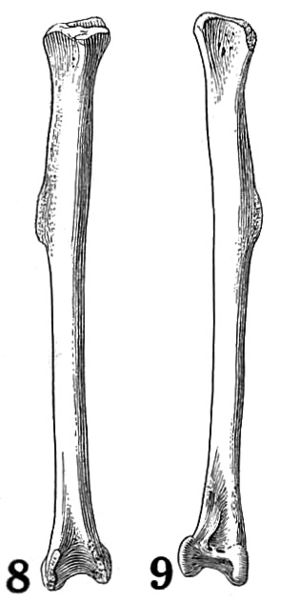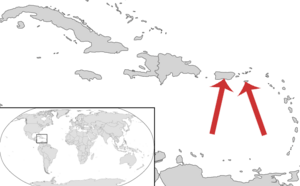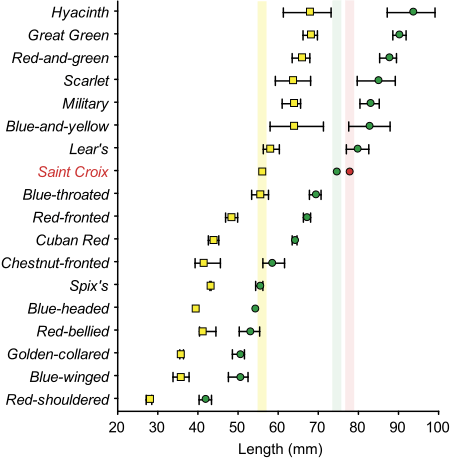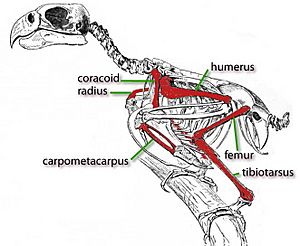St. Croix macaw facts for kids
Quick facts for kids St. Croix macawTemporal range: Late Holocene
|
|
|---|---|
 |
|
| Holotype left tibiotarsus in two views | |
| Conservation status | |
| Scientific classification | |
| Genus: |
Ara
|
| Species: |
autocthones
|
 |
|
| Red arrows indicate locations on Puerto Rico and St. Croix where remains of this macaw have been found | |
| Synonyms | |
|
Ara autochthones Olson, 1978 (lapsus) |
|
The St. Croix macaw (Ara autocthones), also called the Puerto Rican macaw, was a type of macaw that is now extinct. Its bones have been found on the Caribbean islands of St. Croix and Puerto Rico.
Scientists first described this macaw in 1937. They based their description on a leg bone called a tibiotarsus. This bone was found in a kitchen midden (an ancient trash pile) at a site on St. Croix. Later, in 2008, more bones from a similar site on Puerto Rico were described.
The St. Croix macaw is one of 13 types of extinct macaws thought to have lived in the Caribbean. However, it is hard to know if these birds were native to the islands or if humans brought them there. People often moved macaws over long distances in ancient times.
Since only bones exist, we do not know the St. Croix macaw's color. Its bones show it was a medium-sized bird. It was a bit bigger than the extinct Cuban macaw. Only the blue-throated macaw and Lear's macaw are similar in size today. Scientists believe humans caused the St. Croix macaw to become extinct. This is because its bones were found in ancient human trash piles.
Contents
Discovering the St. Croix Macaw
In 1934, an archeologist named Lewis J. Korn found some interesting bones. He was digging at an ancient site near Concordia on the island of St. Croix. This site was a "kitchen midden," which is like an old garbage dump. It contained bones from animals that people ate.
The midden was about 400 meters (437 yards) from the beach. It was also about 30 inches (76 cm) deep. Scientists found bones of mammals, birds, turtles, and fish. The bird bones were mostly in the middle part of the dump.
Scientists believe the site was very old, from before Europeans arrived. It was likely between 500 and 800 years old. Among the bones, they found 23 different bird species. Some of these birds are now extinct.
First Bone Found in St. Croix
In 1937, a bird expert named Alexander Wetmore studied these bones. He found a left lower leg bone (tibiotarsus) from a young macaw. This was a surprise because no macaws were known from St. Croix before.
Wetmore named this bone the "holotype" for a new macaw species. He put it in the Ara group of macaws. He called it Ara autocthones. The name autocthones comes from ancient Greek. It means "native" or "aborigine."
The bone is kept at the U.S. National Museum of Natural History. At that time, the only other extinct Caribbean macaw known from bones was the Cuban macaw. Wetmore thought it was important to name this new species, even with some unknowns.
Debate About Its Origin
In 1978, another bird expert, Storrs L. Olson, agreed the bone was from a new macaw. But he wondered if it was truly native to St. Croix. He knew that indigenous Caribbeans often kept and traded macaws. They moved them over long distances.
In 1983, Olson suggested that if the macaw was transported, its name "native" would be wrong. Other scientists also thought it could have been traded. However, some argued that St. Croix could have had its own native macaw. This was because other macaws were known to live in the region.
More Bones Found in Puerto Rico
In 1987, Edgar J. Máiz López found more macaw bones. He found them at an ancient site in Puerto Rico. These bones belonged to a single bird. The site was a large pre-Columbian village.
The macaw bones were found in a kitchen midden. This midden was dated to about 300 AD. The bones included parts of a shoulder bone (coracoid), arm bone (humerus), and leg bones (tibiotarsus and femur).
In 2008, Olson and Máiz López studied these new bones. They decided they belonged to Ara autocthones. The tibiotarsus bone was the same size as the one found in St. Croix.
Olson and Máiz López believed Ara autocthones was native to the West Indies. They thought it was more likely for an island species to go extinct. They still questioned if it was truly native to St. Croix or even Puerto Rico. They felt the name autocthones was "probably one of the worst possible choices."
They noted that ancient people often transported animals. For example, the Puerto Rican hutia (an extinct rodent) and the Antillean cave rail (an extinct flightless bird) were moved to St. Croix. Their bones were also found in kitchen middens.

Scientists also found a shoulder bone (coracoid) on the island of Montserrat. This bone might belong to the St. Croix macaw or the Cuban macaw. Some think it could be from the extinct Lesser Antillean macaw of Guadeloupe.
The bird is called the St. Croix macaw. But after bones were found in Puerto Rico, it is also called the Puerto Rican macaw. Some experts think Puerto Rican macaw is a better name. They believe it was more likely native to Puerto Rico.
Scientists have suggested that 13 extinct macaw species lived in the Caribbean. However, many of these are only known from old drawings or stories. Only the St. Croix macaw and the Cuban macaw are known from actual bones. The Lesser Antillean macaw might also be known from bones.
People moved macaws between islands and from South America to the Caribbean. This happened both in ancient times and when Europeans arrived. Parrots were important to native Caribbean cultures. So, historical records of macaws might not always mean they were native species. They could have been pets that escaped. Finding more bones and studying old reports will help solve these mysteries.
What the St. Croix Macaw Looked Like
Since we only have bones, we do not know what color the St. Croix macaw was. The first leg bone found seemed to be from a fully grown bird. But it was also a bit soft at the ends, meaning it was still young.
This leg bone was about 77.7 mm (3.06 in) long. It was wider than the same bone in the Cuban macaw. This means the St. Croix macaw was a slightly larger bird. It was also more slender than larger macaws.
The St. Croix macaw's leg bone was a medium size. It was between large macaws like the scarlet macaw and smaller ones like the chestnut-fronted macaw. Its bone was more slender than other macaws. It also had a slightly larger upper end. These features helped scientists tell it apart from other species.
Scientists say that living macaws come in two main sizes: large and small. The St. Croix macaw was unique because it was in between these two sizes. Only the blue-throated macaw and Lear's macaw are similar in size.
The St. Croix macaw's bones had some unique features. For example, its humerus (arm bone) had a less deep muscle attachment area. Its femur (thigh bone) was more solid. Its tibiotarsus (lower leg bone) was stronger and flared at the bottom.
Scientists also compared the bones to those of Amazon parrots. They found features only seen in Ara macaws. For example, its coracoid (shoulder bone) was longer and thinner. Its carpometacarpus (hand bone) was much longer. These details confirmed it was a macaw.
Why the St. Croix Macaw Disappeared
All the macaws native to the Caribbean likely became extinct because of humans. This happened both in ancient times and more recently. Strong storms (hurricanes) and diseases might also have played a small part.
Native Caribbean people hunted macaws. They also kept them as pets or for food later. Since the St. Croix macaw's bones were found in ancient trash piles, people clearly ate them.
It is very likely that hunting and keeping them as pets led to the St. Croix macaw's extinction. We do not know the exact date it disappeared.
See also
 In Spanish: Guacamayo de Saint Croix para niños
In Spanish: Guacamayo de Saint Croix para niños



